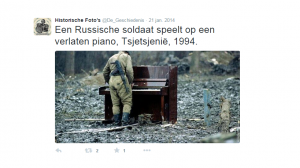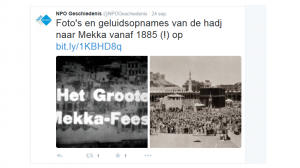“These accounts strip history of the truly fun parts: curiosity, detective work, and discovery” states the academician Rebecca Onion in ‘Snapshots of History’. Her plea focuses on the argument that widely popular Twitter accounts with historical pictures or photographs are bad for understanding history and therefore bad for people. They are failing to provide context of what history is and are never linking to the many real historical resources available on the Web. She noticed this problem around February 2014 when the attribution, practices and accuracy of the feeds had become a source of consternation around the Web. Even if the feed included the name of the photographer, it often remained difficult to discover more background information on the historical events taking place in a given photograph. By not linking to sources or context, history photograph accounts create an impression of history as a glossy, impervious façade, she states.[1]
Nevertheless it is still current. In the Netherlands the same process is happening right now. History accounts sketch history as landscape that is peopled by icons like the Beatles, but also concentration-camp survivors, World War II soldiers and only sometimes everyday scenes. For example, on the Twitter account @De_Geschiedenis historical pictures are provided without context. With the slogan “Breathtaking historical photographs, the good and the evil, the joyful and touching moments of the past. Follow us, cherish the past”, they themselves apparently don’t see the problem. The users themselves are also very passive in giving criticism. On average a photograph gets two ‘retweets’ and two ‘stars’ from the almost three thousand followers. Maybe this debate about context behind historical pictures is one between amateurs and professionals then?
Although I agree with Onion, I am a bit more nuanced. At first it doesn’t necessarily mean that these beautiful, evocative, mostly black and white pictures aren’t useful for providing a historical experience. These tweets show ways in which history is democratic and accessible for everyone. Nevertheless this also can lead to a scan and dump of information like historian Fien Danniau refers to in her article ‘Public History in a Digital Context’.[2] The material is available online, but the contextual information is lost and understanding of the past with it. So the historical experience by these pictures is more significant when some knowledge or context is provided. Secondly, I also want to mention that there are also Twitter accounts, in the Netherlands at least, that are more serious in creating the balance in this historical interest. Just as Onions purpose on @SlateVault is to surface compelling, beautiful or funny items that reward a second look and lead you to a newly digitized archive or good historical read, for example @NPOGeschiedenis does the same (and adds also moving images and audio material).
Clearly, in the Netherlands the same problem Onion mentioned is occurring, but what to do with it is questionable. Onion herself, as historical writer for the academic world as well for the Web, knows how hard it is to talk about history online. A historical document was produced by somebody, at a certain time, under certain conditions. To historians these details, and the questions they provoke, are what give historical documents dimension.[3] But is that what the public wants?
Maybe the distinction between the accounts driven by historians or at least professionals and the ones by amateurs is already a solitude solution. In this way people can choose by themselves if they want that extra information or not. Wheter they want to follow the more ‘serious’ @NPOGeschiedenis and @SlateVault or accounts like @De_Geschiedenis and @HistoricalPics for just the scenic black and white photographs. If we still wish to combine these two concepts and make history on Twitter fully democratic and informative than we should ask people to share their thoughts and feelings about the photographs, link to sources or other contextual information in a reaction and look further on the subject. This kind of democratization with Twitter and historical pictures is what I mean with a real historical experience for the public instead of a historical façade. Maybe it is an illusion that this works, but it is good to keep on dreaming.
Written by Eline Kemps
[1] R. Onion, ‘Snapshots of History’, Slate, (5 February 2014) 1,2.
[2] F. Danniau, ‘Public History in a Digital Context: Back to the Future or Back to Basics?’, BMGN – Low Countries Historical Review 128- 4 (December 2013) 135.
[3] Onion, ‘Snapshots of History’, 2.

